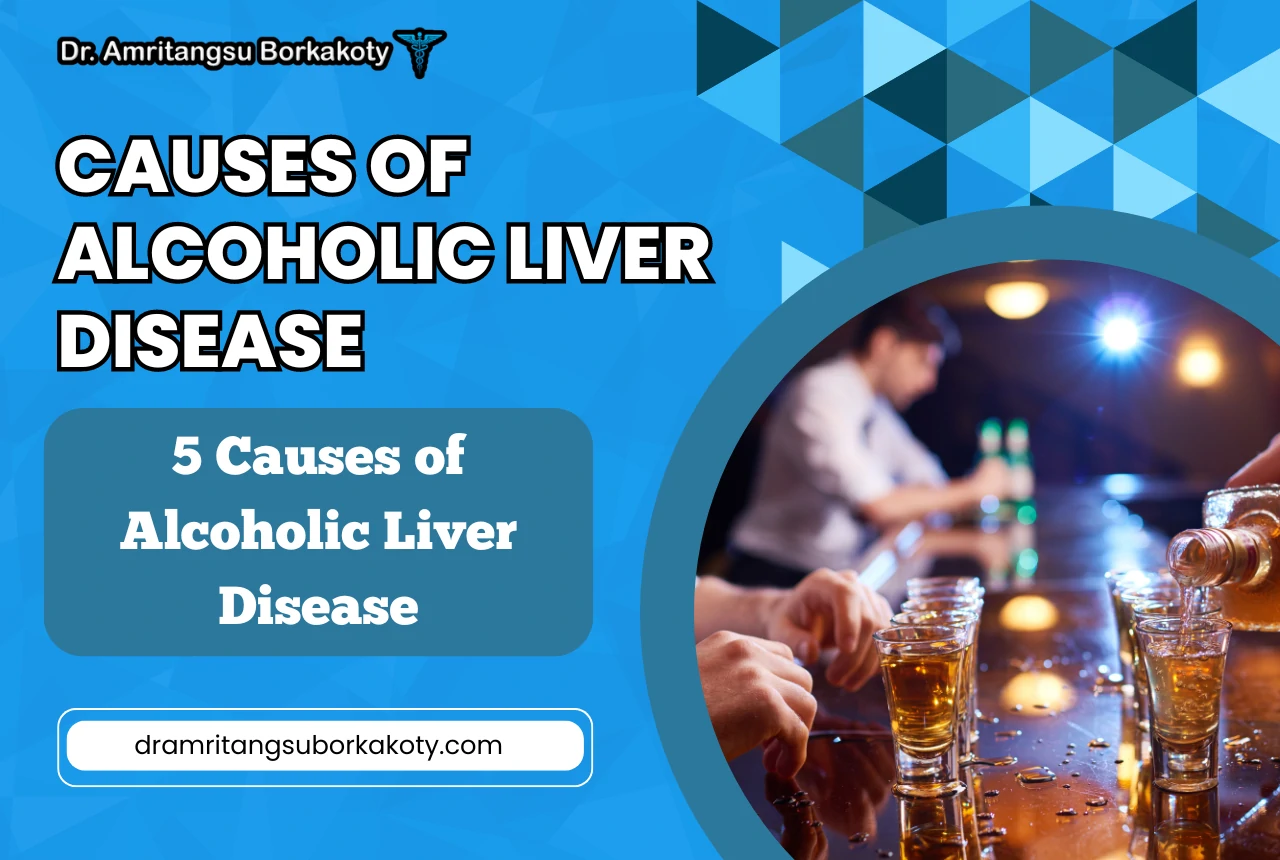
-
 Posted By Dr. Amritangsu Borkakoty
Posted By Dr. Amritangsu Borkakoty -
-
Comments 0
There are multiple causes of alcoholic liver disease that should be prevented as the liver is an essential organ that filters blood, produces bile, and metabolises nutrients. Unfortunately, excessive alcohol consumption can severely damage this organ, resulting in alcoholic liver disease (ALD). The prevalence of ALD is increasing, generating severe concerns for public health.
This blog will look into the fundamental causes of ALD and investigate why it is getting more frequent. Understanding the elements that contribute to this illness allows us to better grasp the consequences of excessive alcohol use and take preventative measures.
These are the Main Causes of Alcoholic Liver Disease
When alcohol is consumed, the liver is responsible for breaking it down. This process involves enzymes that convert alcohol into harmful byproducts. Over time, prolonged exposure to these byproducts can lead to liver damage.
Stages of Alcoholic Liver Disease
Alcoholic liver disease (ALD) progresses in stages, each characterized by increasing severity:
- Fatty Liver (Steatosis): In this initial stage, excess fat accumulates in liver cells. While fatty liver can often be reversed with lifestyle changes, continued alcohol consumption can lead to more severe damage.
- Alcoholic Hepatitis: This stage involves inflammation and cell damage caused by alcohol-related toxins. Alcoholic hepatitis can be a serious condition with symptoms such as fever, abdominal pain, and jaundice.
- Alcoholic Cirrhosis: The most advanced stage of ALD, cirrhosis involves irreversible scarring of the liver tissue. This scarring can interfere with the liver’s ability to function properly, leading to a range of serious complications including liver failure, internal bleeding, and increased risk of liver cancer.
Factors Influencing the Severity of ALD
Several factors can influence the severity of ALD, including:
- Quantity and Duration of Alcohol Consumption: The more alcohol a person consumes and the longer they drink, the greater their risk of developing ALD. This “dose-dependent” relationship highlights the importance of reducing alcohol intake to prevent liver damage.
- Gender: Women are generally more susceptible to ALD than men, even when consuming similar amounts of alcohol. This increased risk is attributed to hormonal differences and metabolic factors.
- Genetics: Certain genetic factors can increase a person’s vulnerability to ALD. These genetic variations can influence how the liver metabolizes alcohol and responds to its harmful effects.
- Nutrition: Poor nutrition, including malnutrition and obesity, can exacerbate ALD. A healthy diet is essential for supporting liver function and reducing the risk of complications.
- Pre-existing Liver Conditions: Individuals with pre-existing liver conditions, such as hepatitis C or fatty liver disease, are at a higher risk of developing ALD. These conditions can accelerate the progression of liver damage.
Reason 1: Increased Alcohol Consumption Patterns

Over the last few decades, there has been an alarming increase in alcohol intake, particularly among young individuals. Binge drinking, which is defined as consuming five or more drinks in a single sitting for males and four or more drinks for women, has become more common.
According to the National Institute on Alcohol Abuse and Alcoholism (NIAAA), the proportion of college students who report binge drinking has remained relatively stable in recent years. This tendency reflects a rising acceptance of excessive alcohol drinking in certain social circles.
Several variables contribute to the increase in alcohol intake. Social pressures, peer influence, and the normalisation of alcohol in popular culture can all lead to increased drinking frequency and quantity. Furthermore, the availability and affordability of alcohol, particularly in college towns and urban regions, can encourage excessive drinking.
Reason 2: Growing Stress and Mental Health Issues

The rising prevalence of stress, worry, and depression has been related to increased alcohol usage as a coping strategy. When confronted with overwhelming obstacles or negative emotions, people may turn to alcohol to self-medicate and temporarily escape their sensations.
Mental health concerns, particularly among young individuals, have increased in recent years. Academic pressures, social media comparisons, and economic instability can all lead to increased stress and anxiety. Furthermore, cultural stigma and limited access to mental health resources can make it challenging for people to seek treatment and develop effective coping methods.
As a result, many people may turn to alcohol as a relatively simple and accessible approach to cope with their mental health issues. However, long-term alcohol misuse can compound these problems and create a vicious cycle of dependence.
Reason 3: Marketing and Accessibility of Alcohol

Alcohol companies have become increasingly adept at targeting younger demographics through aggressive marketing strategies. These tactics often involve the use of social media, influencers, and event sponsorships to create a positive and aspirational image of alcohol consumption. By associating alcohol with fun, excitement, and social acceptance, these companies can influence the attitudes and behaviors of young people.
The availability of alcohol has also increased in recent years, with online delivery services making it easier than ever to purchase alcoholic beverages. This increased accessibility can contribute to a culture of convenience and normalization of alcohol consumption.
Concerns have been raised about the impact of alcohol advertising on public health, particularly among young people. Some argue that aggressive marketing can contribute to underage drinking and promote unhealthy drinking behaviors. As a result, there have been calls for stricter regulations on alcohol advertising, including restrictions on certain types of marketing and the use of targeted advertising techniques.
Reason 4: Lack of Awareness and Early Detection

One of the difficulties in treating ALD is that the early stages of the disorder sometimes do not produce distinct or noticeable symptoms. ALD’s quiet nature makes it difficult to detect and treat in a timely manner.
Public health initiatives are essential for raising knowledge about the symptoms, risk factors, and effects of ALD. By educating the public about the dangers of excessive alcohol use and the need of early detection, these efforts can urge people to seek medical assistance if they notice any symptoms.
Regular health checks and early detection of ALD are critical for enhancing treatment outcomes. Healthcare practitioners can adopt treatments to prevent the illness from progressing and minimise complications if it is detected early. This can include lifestyle changes, drugs, or, in certain situations, liver transplantation.
Reason 5: Socioeconomic Disparities in Healthcare Access

Socioeconomic gaps in healthcare access have a considerable impact on ALD prevention, diagnosis, and treatment. Low-income people frequently have restricted access to healthcare services, including preventive measures like routine check-ups and screenings. This lack of access can cause a delay in ALD diagnosis, allowing the disorder to advance to more severe stages before being diagnosed.
When low-income people seek medical care, they may encounter challenges such as high expenses, limited insurance coverage, and difficulties finding appropriate healthcare providers. These issues can impede their capacity to receive prompt and effective treatment for ALD, resulting in poorer outcomes.
To alleviate these inequities, it is critical to create healthcare access programs for vulnerable people. These programs may involve subsidised healthcare, community health clinics, and outreach campaigns aimed at educating and supporting those at risk of ALD. By enhancing healthcare access, we can help to mitigate the impact of socioeconomic differences on the prevention and treatment of this disorder.
Conclusion
The increasing prevalence of alcoholic liver disease (ALD) is a serious public health concern. Several factors contribute to this rise, including increased alcohol consumption patterns, growing stress and mental health issues, aggressive marketing of alcohol, lack of awareness and early detection, and socioeconomic disparities in healthcare access.
To prevent ALD, it is crucial to limit alcohol consumption and adopt healthy lifestyle habits. These include maintaining a balanced diet, exercising regularly, and managing stress effectively. Early detection and treatment can also improve outcomes for individuals with ALD.
Treatment options for ALD may vary depending on the stage of the disease and the severity of symptoms. They can include lifestyle changes, medications, and in some cases, liver transplantation. It is important to seek professional help if you or someone you know is experiencing symptoms of ALD.
By raising awareness about the risks of ALD and promoting prevention strategies, we can work towards reducing the prevalence of this condition and improving the health and well-being of individuals and communities.
Recent Posts
- Early Symptoms of Liver Damage: How to Spot the First Warning Signs Before It’s Too Late
- Best Treatment for Hepatitis B and C: Your Complete Guide to Symptoms, Care, and Prevention
- How to Reduce Liver Inflammation Fast: 5 Proven Tips for Rapid Liver Recovery
- Why You Shouldn’t Ignore NAFLD: 5 Shocking Health Risks You Need to Know
- Nutrient Rich Food for Liver: 6 Powerful Foods That Transform Liver Health


